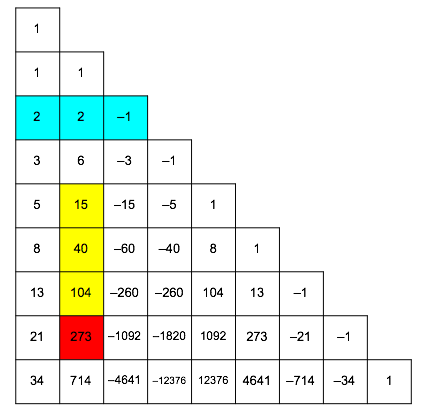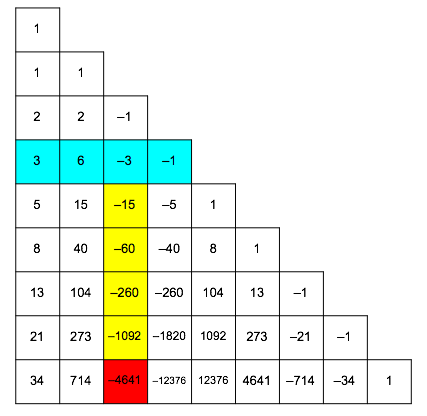Hans Walser, [20150820]
Fibonacci triangle
1 The triangle
Figure 1 gives the Fibonacci triangle.

Fig. 1: Fibonacci triangle
In Figure 2 we see an orthogonal arrangement.

Fig. 2: Orthogonal arrangement
2 Notation
For the Fibonacci numbers we use the usual upper case notation:
![]() (1)
(1)
For the Fibonacci triangle we will use the lower case notation of Figure 3.

Fig. 3: Notation
3 Features of the Fibonacci triangle
3.1 The Fibonacci numbers
The numbers in the first column of Figure 2 are the usual Fibonacci numbers:
![]() (2)
(2)
The Fibonacci numbers appear also under the roof:
![]() (3)
(3)
3.2 Signs
The signs change every second step (Fig. 4).

Fig. 4: Signs
3.3 Symmetry
The Fibonacci triangle is not symmetric. But leaving away the ŇroofÓ on the right and ignoring the signs there is an axial symmetry (Fig. 5).

Fig. 5: Quasi symmetry
4 Powers of the Fibonacci numbers
4.1 Squares and cubes
Lets begin with a common picture (Fig. 6). It depicts the growth of the Fibonacci numbers. Beginning with a unit square we get the Fibonacci numbers for the side lengths of the square sequence. And of course we have the recursion:
![]() (4)
(4)

Fig. 6: Fibonacci squares
For
the areas of the squares we obtain the sequence ![]() :
:
1, 1, 4, 9, 25, 64, 169, 441, 1156, ... (5)
Playing with these numbers we find a three digits recursion:
![]() (6)
(6)
Example:
![]() (7)
(7)
That means,
that in Figure 6 the green and the cyan square have together half the area of
the yellow plus the blue square. This can be seen by the dissection proof of
Figure 7.

Fig. 7: Dissection
Notice that the coefficients of (6) appear in the Fibonacci triangle:
![]() (8)
(8)
For
the cubes ![]() of the Fibonacci numbers we have:
of the Fibonacci numbers we have:
1, 2, 8, 27, 125, 512, 2197, 9261, 39304, ... (9)
Here we find a four digits recursion:
![]() (10)
(10)
Example:
![]() (11)
(11)
4.2 General powers
For the kth power of the Fibonacci numbers there is a (k + 1) digits recursion:
![]() (12)
(12)
For the proof of (12) I used a computer algebra system.
5 The elements of the Fibonacci triangle
5.1 Columns
We have already found (2) the Fibonacci numbers in the first column of Figure 2.
In the next column of Figure 2 we have the products of two consecutive Fibonacci numbers:
![]() (13)
(13)
Example:
![]() (14)
(14)
Again in the next column we get products of three consecutive Fibonacci numbers, but with a negative sign an a coefficient of one half:
![]() (15)
(15)
Example:
![]() (16)
(16)
5.2 Overview
For the first five columns we get:
|
|
|
|
|
|
|
|
|
|
The
denominators in the coefficients are the products of consecutive Fibonacci
numbers beginning with ![]() (kind of ŇfactorialÓ):
(kind of ŇfactorialÓ):
 (17)
(17)
5.3 General
Finally we get the general formula for the elements of the Fibonacci triangle:
 (18)
(18)
6 Recursion in the Columns
The elements in the columns of the Fibonacci triangle fulfill a recursion like the recursion (12) for the powers of the Fibonacci numbers. Id est:
![]() (19)
(19)
Examples:
First example: n = 7, k = 1
![]() (20)
(20)
Figure 8 shows the involved elements. Red is the dot product of cyan and yellow.

Fig. 8: Dot product
Second example: n = 8, k = 2
![]()
In Figure 9 the involved elements:

Fig. 9: Involved elements